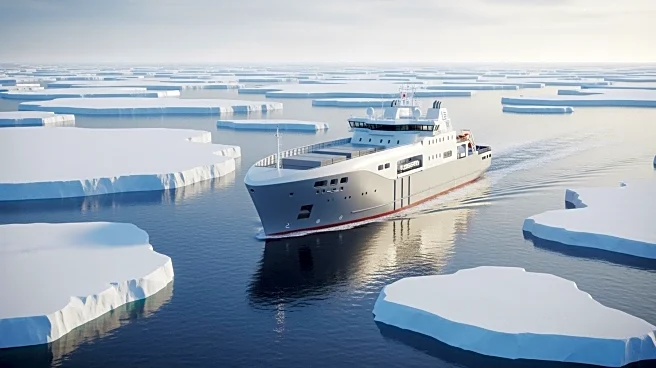What's Happening?
A Chinese container ship, the Istanbul Bridge, has completed a pioneering voyage from China to Europe via the Arctic, marking the first use of the 'Ice Silk Road' for container shipping. The journey, which
took 26 days, was significantly faster than traditional routes such as the Suez Canal. The ship made stops in the UK, Germany, and Poland, and is expected to reach the Netherlands soon. This new route is part of China's Belt and Road Initiative and is designed for high-value goods and cross-border e-commerce. The Arctic passage, accessible only a few months per year, offers new opportunities for global trade as climate change reduces ice coverage.
Why It's Important?
The successful completion of this Arctic route highlights the potential for faster and more efficient global trade routes, which could significantly impact international shipping and logistics. By reducing delivery times, especially for sensitive cargo, this route could enhance trade between China and Europe. The development of the 'Ice Silk Road' also underscores China's strategic interests in the Arctic, a region increasingly important in the U.S.-China rivalry. The route's success could lead to increased shipping activity in the Arctic, affecting global trade patterns and economic relations.
What's Next?
The Arctic route provides a new option for companies shipping high-tech cargo from China to Europe. As ice coverage continues to shrink, the strategic implications of Arctic shipping routes will grow, potentially affecting security dynamics in the region. The route's success may encourage other shipping companies to explore Arctic passages, further integrating them into global trade networks. Additionally, the environmental impact of increased Arctic shipping will likely become a topic of discussion among policymakers and environmental groups.
Beyond the Headlines
The opening of Arctic shipping routes raises ethical and environmental concerns, particularly regarding the impact on Arctic ecosystems and indigenous communities. As shipping activity increases, there may be calls for stricter regulations to protect the fragile Arctic environment. The geopolitical implications of Arctic routes also warrant attention, as countries vie for influence in the region. The development of these routes could lead to shifts in global power dynamics, with China and Russia strengthening their presence in the Arctic.













